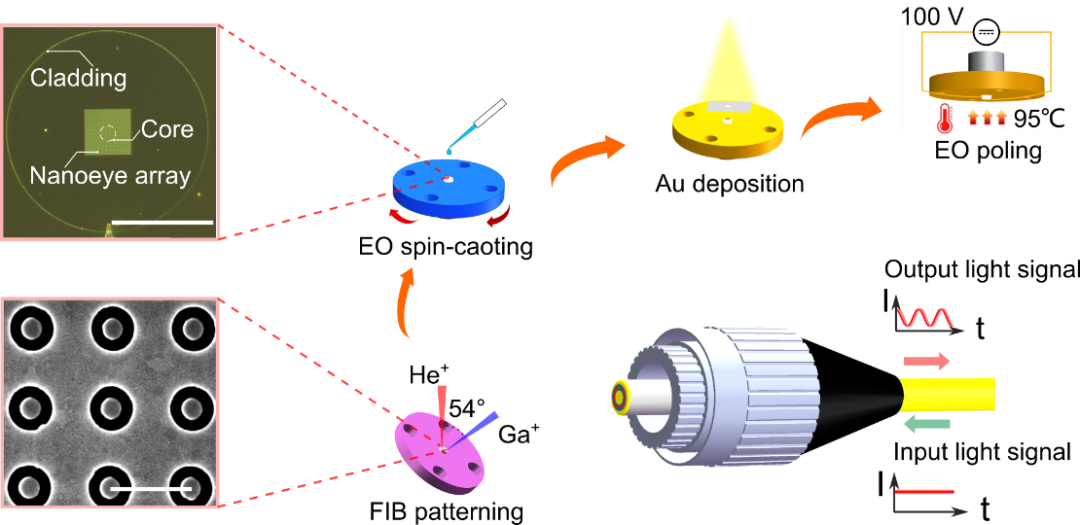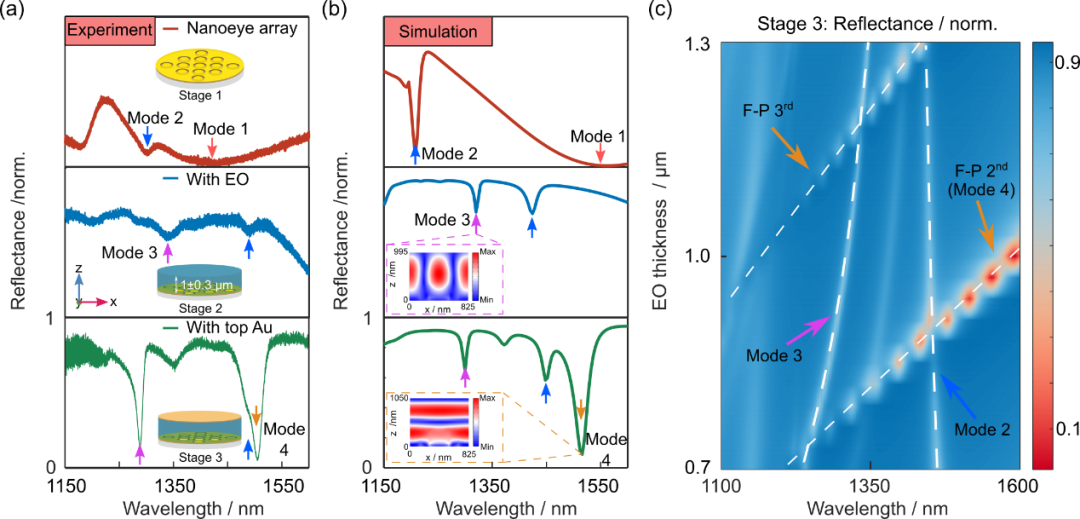Electro-optical modulator is one of the core devices in the field of optical communication. By applying an external electrical signal, the amplitude, phase, polarization and even frequency of the light wave are changed, so as to load the external modulation signal onto the light wave and realize the conversion of electro-optical signals. Traditional on-chip integrated electro-optical modulators often have large coupling losses when accessing or working together in an optical communication network because of the difficult mode-field matching between the on-chip optical waveguide and the optical fiber. Although the coupling loss can be reduced by more advanced coupling processes, such as end-face coupling and grating coupling, there still exists the limitation of low integration rate and narrow operating bandwidth. In addition, existing coupling methods require extremely precise alignment operations and packaging processes, which greatly increase the cost of on-chip electro-optical modulators.
In order to avoid additional coupling requirements, reduce coupling losses, and broaden the application of superstructured optical fiber [1] in electro-optic devices, the research team of Qiu Min at Xihu University, together with the research team of Wang Jiyong at Hangzhou University of Electronic Science and Technology, developed a processing method to integrate electro-optic modulators directly on commercial single-mode optical fiber patch cords [2] (Fig. 1). The superstructured fiber electro-optic modulators can work stably in O and S bands and reach a maximum modulation rate of 1 GHz, and the related research results were published in Light: Science & Applications under the title of "Plasmonic metafibers electro-optic modulators". Science & Applications.
Highlights of the research
As shown in Figure 1, the collaborative team has developed processing processes for integrating micro- and nanofunctional structures on the end face of single-mode fiber optic patch cords: focused ion beam etching (FIB), spin-coating, and physical vapor deposition. Utilizing this set of processes, precise integration of ultra-surfaces and electro-optic polymers can be achieved with high stability and accuracy. Fiber optic patchcords provide a larger plane of operation (approximately 1800 um in diameter) than bare fibers (only 125 um in diameter) that contain only the core and cladding, making multi-layer, multi-material micro-nano integration easier to achieve.

Fig. 1 Processing flow diagram for the integration of electro-optical modulators at the fiber endface using standard micro-nano-processing techniques. The upper left inset is an optical microscopy image of the fiber endface after spin-coating the electro-optic polymer, and the lower left inset is an equipartitioned excitonic hypersurface processed at the fiber endface using focused ion beam etching at scales of 62.5 um and 825 nm, respectively.
In addition, the researchers have theoretically designed and systematically analyzed the resonance modes of the hypersurface-electro-optic polymer composite structure, as shown in Fig. 2. At the first stage (only the underlying hypersurface), only optical modes 1 and 2 are present in the reflection spectrum, which originate from the bonding and antibonding hybridization of the respective dipole modes of the nanodiscs and nanoholes. After spin-coating the electro-optic polymer (second stage), a new optical mode 3 appears in the short wavelength direction: the resonant waveguide mode. When entering into the third processing stage (vaporizing the upper layer of gold film), another new optical mode 4: Fabry-Perot resonant cavity mode appeared, as shown in Fig. 2(a, b, c). In addition, they found that by rationally designing the period of the super-surface and the thickness of the electro-optic polymer, they were able to excite two resonance peaks in the O-band and the S-band with high reproducibility. The excitation of these two resonant peaks provides a design idea for tunable dual-band modulation.

Fig. 2 Optical mode analysis of an isotropic excitation superstructure fiber. (a-b) Evolution of optical modes occurring at each processing stage, where (a) is the experimental result and (b) is the simulation result. (c) Mode evolution of modes 2, 3, and Fabry-Perot modes with the change of electro-optic polymer thickness at the third processing stage.
Further, the researchers made a systematic characterization for the modulation properties of the iso-excited excitonic superstructure fiber, as shown in Fig. 3. The test results show that the device exhibits a spectral shift of 3 nm and a modulation depth of 11 % when ±100 V DC bias is applied, and the modulation rate is capable of reaching 1 GHz when Vpp is 18 V, which is the highest modulation rate known for a collector-electrode-based fiber electro-optic modulator. The results provide researchers with new ideas in the design and preparation of ultra-compact, high-performance, all-fiber electro-optic modulation devices.

Fig. 3 Electro-optical modulation performance of an iso-excited excitation superstructure fiber. (a) Experimental setup used to characterize the modulation properties of DC and AC power sources; (b) DC modulation test results. The spectrum experiences a redshift of about 3 nm when the DC bias is varied from -100 V to +100 V. The spectra are shown in the inset. The inset responds to a modulation depth of 11 % at one of the modulation wavelengths (1287 nm). (c) AC bias modulation test results at different frequencies. The upper column shows the variation of modulation amplitude with modulation frequency when Vpp is 2 V; the lower column shows the variation of Vpp with modulation frequency keeping the same modulation amplitude.
Summarize
This work realizes for the first time the integration of electro-optical modulators in the end face of single-mode fiber patch cords. Using the universal connection port of fiber optic patch cords, the existing fiber-waveguide coupling can be replaced by single-mode fiber-fiber optical field coupling, and the plug-and-play, near-zero coupling loss optical interconnection and optical modulation can be realized without mode-field matching, which provides a core solution for the search of spatial optics substitution, the research and development of all-fiber optic system and other apex technologies.
This research is funded and supported by the National Natural Science Foundation of China and the Sino-German Science Center Program. We would like to thank Associate Researcher Yan Wei, School of Engineering, Westlake University, for his guidance in the theoretical simulation of this work, and the Advanced Micro-Nano Processing Platform, Westlake University, for providing instrumentation and technical support. Lei Zhang and Xinyue Sun, PhD students of School of Engineering, Xihu University, are the co-first authors, and Prof. Jiyong Wang of Hangzhou University of Electronic Science and Technology and Prof. Min Qiu of Xihu University are the co-corresponding authors.
Link to the paper:
https://doi.org/10.1038/s41377-023-01255-7
Reprinted from: Westlake University official account

